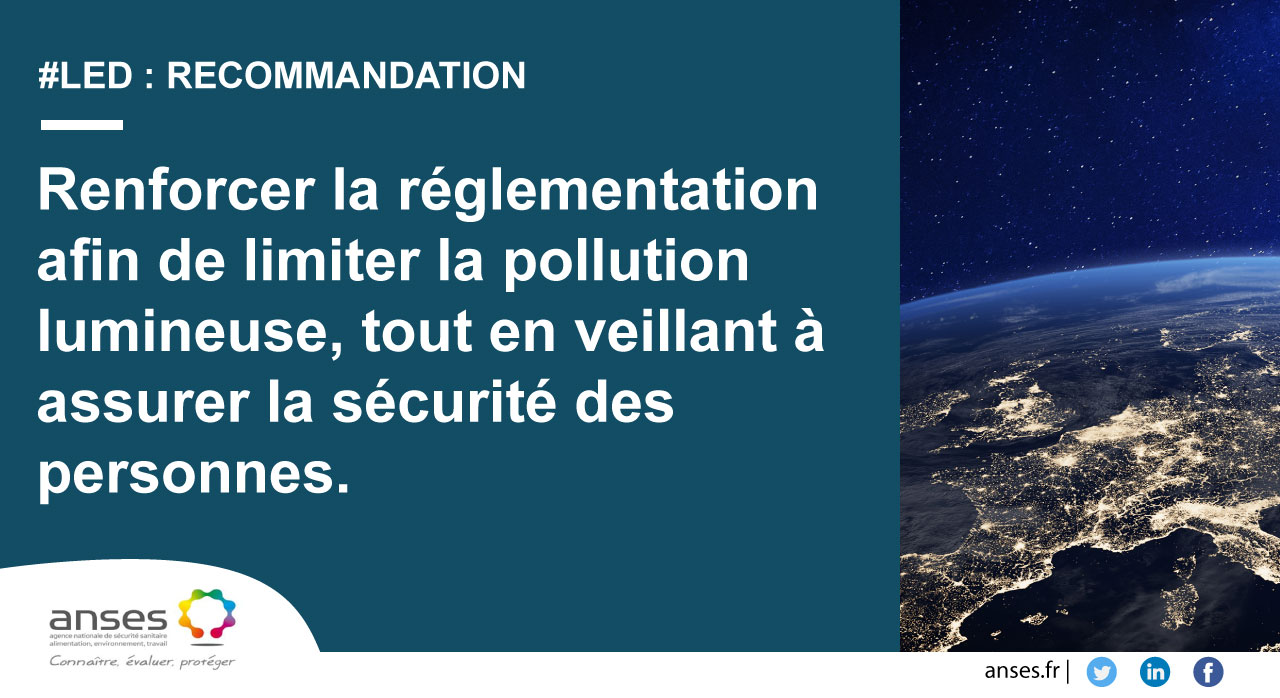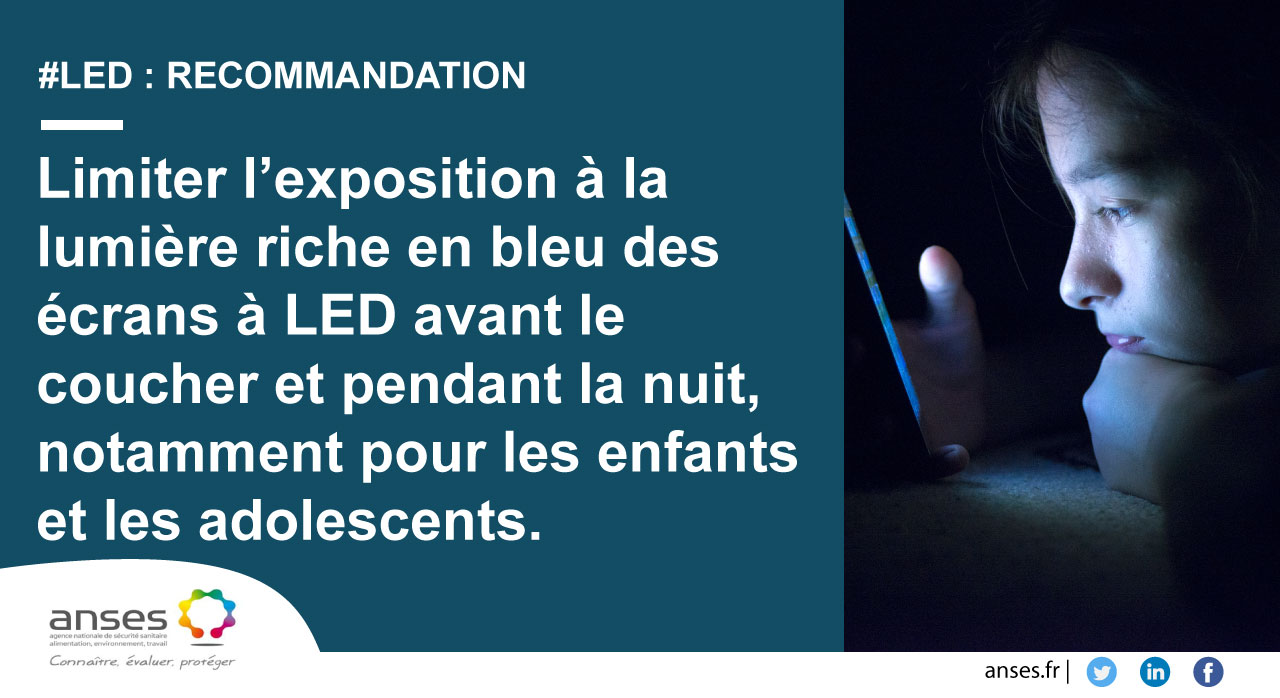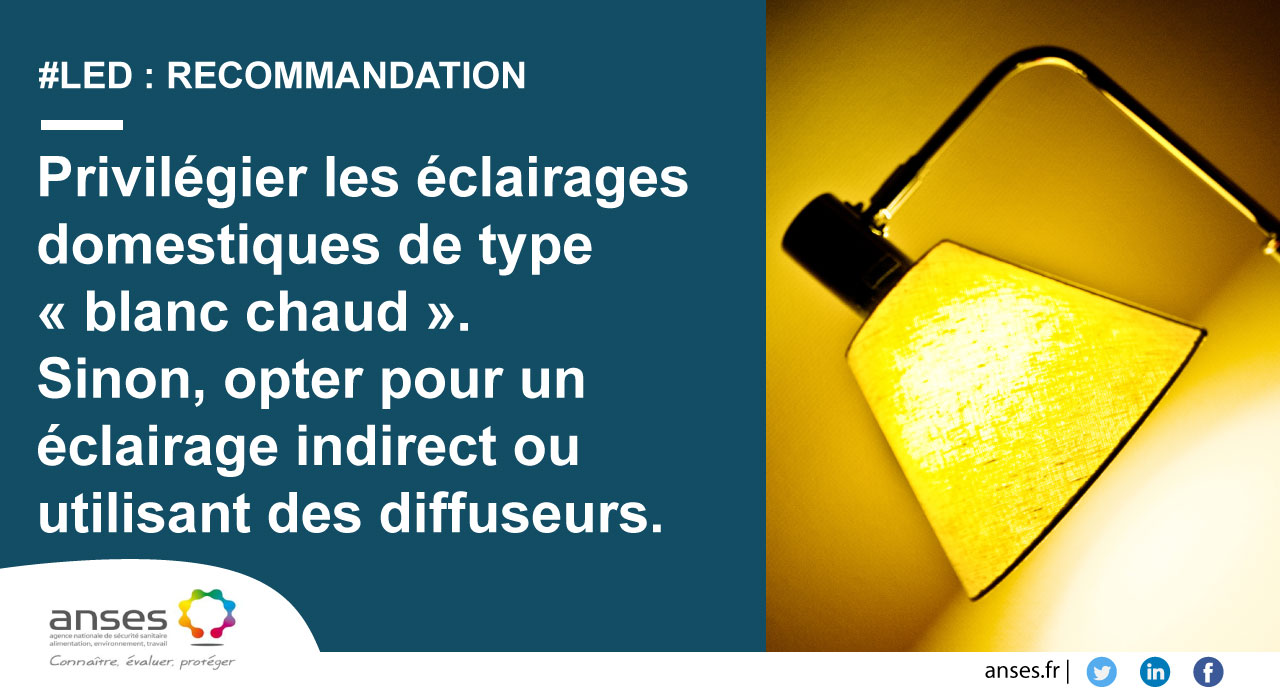
LEDs & blue light
Health effects of lighting systems using light-emitting diodes (LEDs)
What are LEDs?
Light-emitting diodes (LEDs) are electronic light source components used in various lighting systems, screen backlights and light objects. Until the 1990s, LEDs only existed in red, yellow or green and were mainly used as indicator lights in electronic equipment such as remote controls or alarm clocks. With the creation of the first blue LED, it became possible, by covering it with a layer of yellow phosphorus, to create a white light intense enough to be used in lighting. Since then, technological research has continuously improved their performance, focusing in particular on materials and on the combination of different types of LEDs. And so LED technology is used today in many ways: home and public lighting, portable lighting, vehicle lights, illuminated signs, etc.
From blue light to white light
By coupling a blue LED to a layer of phosphorus, usually yellow, a white light is obtained. The respective proportions of blue and yellow emissions make it possible to obtain either a "cold" or a "warm" white. If there is a high proportion of blue in the spectrum of a lamp, the light resembles that of the midday sun and is considered to be on the "cold" side. If red dominates, the light resembles the setting sun and is considered to be "warm" light. However it should be noted that the lower the colour temperature, the “warmer” the light emitted by the LED will be.
ANSES expert assessment of LEDs
Identification of risks related to blue light emitted by LEDs (2010)
At the very beginning of the deployment of this technology, ANSES carried out an initial and unprecedented expert report on LEDs published in 2010. The report highlighted the retinal toxicity of the blue light found in LED lighting and therefore recommended modifying the regulatory and normative framework. As a result, only LED lamps in risk groups 0 or 1 (in accordance with photobiological safety standard NF-EN-62471) are currently available to the general public for domestic lighting. Lighting with the highest risk (groups 2 and 3) are reserved for professional use under conditions that guarantee the safety of workers.
Confirmation of the risks associated with blue light emitted by LEDs (2019)
In 2019, ANSES's new expert assessment provided an update of the state of knowledge since 2010 on the various health effects that may be associated with exposure to blue-rich light and other characteristics of LEDs, which are different from other lighting technologies.
This assessment supports the 2010 result on the toxicity of blue light to the eye, which can lead to impaired vision. It highlights short term effects on the retina linked to intense exposure to blue light, and long term effects linked to the onset of age-related macular degeneration. ANSES recommends restricting the marketing of LED devices that emit overly high levels of blue light through modifications in the specific regulations for devices other than lamps and light fixtures. Furthermore, given the recent experimental data on the mechanisms of phototoxicity, ANSES emphasises in its 2020 Opinion the need to update exposure limit values (ELVs) for exposure to blue light to account for the specificities of children, for whom the lens of the eye filters blue light much less efficiently than that of adults and the elderly.
In addition, ANSES highlights disruptive effects to biological rhythms and sleep, linked to exposure to even very low levels of blue light in the evening or at night, particularly via screens. The Agency therefore recommends limiting population exposure to strong blue light before bedtime and at night, specifically children.
In addition, the Agency points out that means of protection against blue light, such as treated lenses, protective glasses or specific screens, have highly variable levels of effectiveness against the health effects of blue light. ANSES encourages the setting of standards to define the performance criteria for these means of protection.
Finally, the Agency points to the harmful effects of lights at night on biodiversity and the environment. Regardless of the ecosystem studied, scientific knowledge has convergingly shown an increase in mortality and a decrease in the diversity of animal and plant species studied in environments illuminated at night, including by LED lighting. The Agency recommends that regulations be strengthened to limit light pollution, while ensuring the safety of individuals.
RECOMMENDATION
Strengthen regulations to limit light pollution, while ensuring the safety of individuals

> The 2019 news item : LEDs: ANSES’s recommendations for limiting exposure to blue light
LEDs: recommendations for the public
Limit exposure to blue light from LED displays before bedtime and at night, especially for children and adolescents.

Choose "warm white" domestic lighting and opt for indirect lighting or lighting with diffusers.



